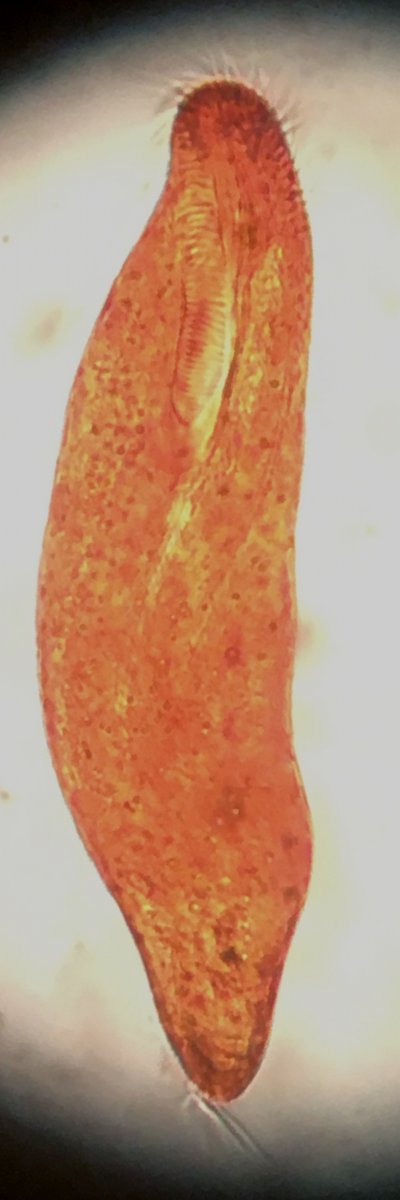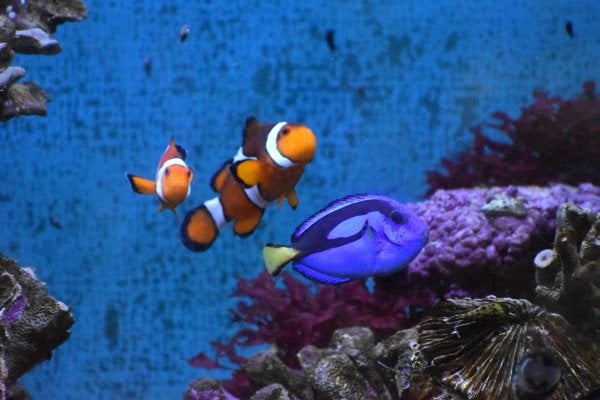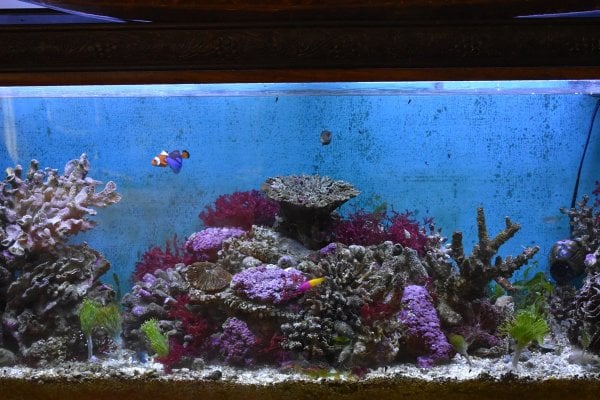I would greatly appreciate your advice regarding the identification of and treatment for a "fluke" that has recently infested my tank and Paracanthurus tang.
I have a marine aquarium that is heavily infested with some form of monogeneans. One fish exhibits overt disease ("blue tang", Acanthuridae: Paracanthurus hepatus; probable infestation of cornea, loss of color in facial region, deterioration of dorsal and caudal fins possibly due to secondary infection). Several other fish are seemingly unaffected (including 15-20 yr old clownfish), but a damselfish that permanently lost facial color many years ago may have been harboring parasites all along. It also has some tattering of pectoral and caudal fins, and both it and a mandarin have developed small (<1 mm) unequally sized white spots within the last days since I began treatment (described below). The tang's behavior is normal. It does "twitch" but this seems to be only in response to human proximity/close observation; it does not seem to twitch when observed from a distance and it does not rub or scratch itself on objects. None of the fish do. None of the fish show labored breathing. I am anxious to identify the parasite at least at a taxonomic level that will help me to decide the best method of treatment, both for the fish and the entire aquarium.
Tank: established >25 years; fish only; 473 liters; temperature 78F, 25.5C; specific gravity typically 1.024 (but currently 1.018, please see below); nitrate ca. 15 mg/l; no ammonia or nitrite test but pH 8.15 and NO3 suggest this isn't an issue; no copper test but no conceivable source of copper; phosphate ~0.32 (Hanna spec; lower by Salifert and Reef Master tests); KH/Alk 10.33-10.5 (Salifert; 9-10 by Reef Master); Ca 430 ppm (Salifert: 380 by Reef Master); Mg 1290; biological filtration (bio-balls in sump, 5-6 cm coral gravel, abundant purple coralline algae, and Gracilaria, Chaetomorpha, and Penicillus macros) and protein skimmer. I apologize the image of my aqarium is not a full view but it is representative of the whole tank.
Inhabitants: 2 Amphiprion ocellaris, 1 Chrysiptera parasema, 1 Pseudochromis paccagnellae, 1 Synchiropus splendidus, 1 Paracanthurus hepatus, various snails (cerithiids, Neritina, Nasarius, unidentified), emerald crabs, bristle worms, tube worms, unidentified worms, more bristle worms, unidentified colonial tunicates, unidentified encrusting sponges, amphipods, copepods, and things that mysteriously come and go as if by spontaneous generation - now to include monogeneans.
It is not practical for me to capture the afflicted tang (though I've not ruled out the possibility entirely), so I have not been able to examine adult parasites. I also have not observed eggs. However, oncomiracidia were suddenly frighteningly abundant on the aquarium glass. None can be found still 2 days after water change and glass cleaning, but I refuse to believe that they are not all over the live rock. I check the glass regularly for copepods and I've never seen oncomiracidia before. I recorded a video that is decidedly of better clarity than the attached still photo, but at 139 Mb the video is too large to upload. You can access it if you wish on my server at:
http://lithornis.nmsu.edu/~phoude/oncomiracidium 139 Mb.MOV
There are a few characteristics I can describe. It is at least somewhat shorter and much narrower than an adult copepod, e.g., Tisbe. It is ciliated on what I interpret as its dorsal side. There are very long and pronounced cilia around its anterior end that beat synchronously and continuously and extend deeply into its pharynx or caecum. The caudal-most cilia are also elongate. It has no eye spots and no anchor hooks that I can discern, so I do not believe this is Neobenedenia even if that is the most common scourge of marine aquaria. The oncomiracidia on the glass of the aquarium are considerably more elongate than the one in my image, and they are quite active. Under the microscope they become shorter in length and soon disintegrate, possibly killed by the focused microscope light.
Question: Can you identify this to a level that would assist in determining the best treatment?
Question: I dosed the tank once with praziquantel to a concentration of 2.5 mg/l (on 2021/02/27) given my crude estimate of tank water volume after displacement by gravel and live rock. I've been supplementing frozen food diet (San Fransisco mysis, brine shrimp, and Emerald Entree, and Ocean Nutrition Formula 2) with metronidazole (SeaChem Metroplex) and nitrofurantoin (SeaChem Focus) garlic extract and Brightwell's Aminomega daily for 3-4 weeks. I have read some conflicting information regarding the appropriate dosing of praziquantel that I hope you can arbitrate. Hikari's Prazipro recommends dosing of 2.5 mg/l with the potential for re-dosing in 5-7 days but as early as 3 days, and that seems to be the popular opinion. However, several published references suggest that 2.5 mg/l should be added every 2 days until 10 mg/l is reached. I'd appreciate advice on protocol or alternative treatments.
Question: Reefs.com (Joe Rowlett) advocates reducing salinity to 15 ppt for 5 days (specific gravity 1.011), citing several studies on its effectiveness for treating for Neobenedenia. One of those references specifically found 18 ppt (SG 1.013) ineffective. That frightens me. Is 15 ppt safe for fish? Is it safe for snails, crabs, coralline algae, copepods, etc? (no live corals) Marine Parasites.com provides an interactive tool for scheduling re-dosing (without specifying dosage) based on temperature and salinity; but it makes no distinction of efficacy at different salinities. Regardless, I don't believe I am dealing with Neobenedenia. I have somewhat reluctantly already reduced specific gravity to 1.018 with the aim of continuing to decrease salinity, but only as low as you recommend. Is hyposalinity plus medication more effective, contraindicated, or inconsequential?
Question: What OTC fish anaesthetic is tang safe?


I have a marine aquarium that is heavily infested with some form of monogeneans. One fish exhibits overt disease ("blue tang", Acanthuridae: Paracanthurus hepatus; probable infestation of cornea, loss of color in facial region, deterioration of dorsal and caudal fins possibly due to secondary infection). Several other fish are seemingly unaffected (including 15-20 yr old clownfish), but a damselfish that permanently lost facial color many years ago may have been harboring parasites all along. It also has some tattering of pectoral and caudal fins, and both it and a mandarin have developed small (<1 mm) unequally sized white spots within the last days since I began treatment (described below). The tang's behavior is normal. It does "twitch" but this seems to be only in response to human proximity/close observation; it does not seem to twitch when observed from a distance and it does not rub or scratch itself on objects. None of the fish do. None of the fish show labored breathing. I am anxious to identify the parasite at least at a taxonomic level that will help me to decide the best method of treatment, both for the fish and the entire aquarium.
Tank: established >25 years; fish only; 473 liters; temperature 78F, 25.5C; specific gravity typically 1.024 (but currently 1.018, please see below); nitrate ca. 15 mg/l; no ammonia or nitrite test but pH 8.15 and NO3 suggest this isn't an issue; no copper test but no conceivable source of copper; phosphate ~0.32 (Hanna spec; lower by Salifert and Reef Master tests); KH/Alk 10.33-10.5 (Salifert; 9-10 by Reef Master); Ca 430 ppm (Salifert: 380 by Reef Master); Mg 1290; biological filtration (bio-balls in sump, 5-6 cm coral gravel, abundant purple coralline algae, and Gracilaria, Chaetomorpha, and Penicillus macros) and protein skimmer. I apologize the image of my aqarium is not a full view but it is representative of the whole tank.
Inhabitants: 2 Amphiprion ocellaris, 1 Chrysiptera parasema, 1 Pseudochromis paccagnellae, 1 Synchiropus splendidus, 1 Paracanthurus hepatus, various snails (cerithiids, Neritina, Nasarius, unidentified), emerald crabs, bristle worms, tube worms, unidentified worms, more bristle worms, unidentified colonial tunicates, unidentified encrusting sponges, amphipods, copepods, and things that mysteriously come and go as if by spontaneous generation - now to include monogeneans.
It is not practical for me to capture the afflicted tang (though I've not ruled out the possibility entirely), so I have not been able to examine adult parasites. I also have not observed eggs. However, oncomiracidia were suddenly frighteningly abundant on the aquarium glass. None can be found still 2 days after water change and glass cleaning, but I refuse to believe that they are not all over the live rock. I check the glass regularly for copepods and I've never seen oncomiracidia before. I recorded a video that is decidedly of better clarity than the attached still photo, but at 139 Mb the video is too large to upload. You can access it if you wish on my server at:
http://lithornis.nmsu.edu/~phoude/oncomiracidium 139 Mb.MOV
There are a few characteristics I can describe. It is at least somewhat shorter and much narrower than an adult copepod, e.g., Tisbe. It is ciliated on what I interpret as its dorsal side. There are very long and pronounced cilia around its anterior end that beat synchronously and continuously and extend deeply into its pharynx or caecum. The caudal-most cilia are also elongate. It has no eye spots and no anchor hooks that I can discern, so I do not believe this is Neobenedenia even if that is the most common scourge of marine aquaria. The oncomiracidia on the glass of the aquarium are considerably more elongate than the one in my image, and they are quite active. Under the microscope they become shorter in length and soon disintegrate, possibly killed by the focused microscope light.
Question: Can you identify this to a level that would assist in determining the best treatment?
Question: I dosed the tank once with praziquantel to a concentration of 2.5 mg/l (on 2021/02/27) given my crude estimate of tank water volume after displacement by gravel and live rock. I've been supplementing frozen food diet (San Fransisco mysis, brine shrimp, and Emerald Entree, and Ocean Nutrition Formula 2) with metronidazole (SeaChem Metroplex) and nitrofurantoin (SeaChem Focus) garlic extract and Brightwell's Aminomega daily for 3-4 weeks. I have read some conflicting information regarding the appropriate dosing of praziquantel that I hope you can arbitrate. Hikari's Prazipro recommends dosing of 2.5 mg/l with the potential for re-dosing in 5-7 days but as early as 3 days, and that seems to be the popular opinion. However, several published references suggest that 2.5 mg/l should be added every 2 days until 10 mg/l is reached. I'd appreciate advice on protocol or alternative treatments.
Question: Reefs.com (Joe Rowlett) advocates reducing salinity to 15 ppt for 5 days (specific gravity 1.011), citing several studies on its effectiveness for treating for Neobenedenia. One of those references specifically found 18 ppt (SG 1.013) ineffective. That frightens me. Is 15 ppt safe for fish? Is it safe for snails, crabs, coralline algae, copepods, etc? (no live corals) Marine Parasites.com provides an interactive tool for scheduling re-dosing (without specifying dosage) based on temperature and salinity; but it makes no distinction of efficacy at different salinities. Regardless, I don't believe I am dealing with Neobenedenia. I have somewhat reluctantly already reduced specific gravity to 1.018 with the aim of continuing to decrease salinity, but only as low as you recommend. Is hyposalinity plus medication more effective, contraindicated, or inconsequential?
Question: What OTC fish anaesthetic is tang safe?



















